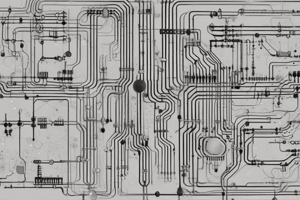Podcast
Questions and Answers
What is the direction of the magnetic field lines?
What is the direction of the magnetic field lines?
- Left-hand rule
- It depends on the type of magnet
- Right-hand rule (correct)
- It is always vertical
What is the unit of measurement for electric charge?
What is the unit of measurement for electric charge?
- Ampere
- Ohm
- Coulomb (correct)
- Volt
What type of wave requires a medium?
What type of wave requires a medium?
- Mechanical wave (correct)
- Electromagnetic wave
- Sound wave
- Light wave
What is the formula for the force exerted on a moving charge in a magnetic field?
What is the formula for the force exerted on a moving charge in a magnetic field?
What is the unit of measurement for temperature?
What is the unit of measurement for temperature?
What is the energy of motion?
What is the energy of motion?
Flashcards are hidden until you start studying
Study Notes
Electricity
- Electric Charge:
- Positive and negative charges
- Like charges repel, opposite charges attract
- Charge is measured in coulombs (C)
- Electric Current:
- Flow of electrons from negative to positive terminal
- Measured in amperes (A)
- Ohm's Law: I = V/R (current = voltage / resistance)
- Electric Circuits:
- Series circuits: components connected one after another
- Parallel circuits: components connected between same points
- Resistors, capacitors, and inductors are common circuit components
Magnetism
- Magnetic Fields:
- Created by moving charges or changing electric fields
- Measured in teslas (T)
- Direction of magnetic field lines: right-hand rule
- Magnetic Forces:
- Acting on moving charges or currents
- F = qvB sin(θ) (force = charge * velocity * magnetic field * sine of angle)
- Electromagnets:
- Coils of wire wrapped around a core, carrying current
- Strength of magnetic field depends on number of turns, current, and core material
Waves
- Types of Waves:
- Mechanical waves: require a medium (e.g., water, air)
- Electromagnetic waves: no medium required (e.g., light, radio)
- Wave Characteristics:
- Amplitude: maximum displacement from equilibrium
- Frequency: number of oscillations per second (Hz)
- Wavelength: distance between consecutive oscillations
- Speed: wavelength * frequency
- Wave Interactions:
- Reflection: wave bounces back
- Refraction: wave changes direction
- Diffraction: wave bends around obstacles
Thermodynamics
- Temperature:
- Measure of average kinetic energy of particles
- Measured in Kelvin (K) or Celsius (°C)
- Heat Transfer:
- Conduction: direct contact between particles
- Convection: transfer through fluid motion
- Radiation: transfer through electromagnetic waves
- Laws of Thermodynamics:
- Zeroth Law: thermal equilibrium
- First Law: energy conservation (ΔE = Q - W)
- Second Law: entropy increase (ΔS = ΔQ / T)
Mechanics
- Motion:
- Displacement: change in position
- Velocity: rate of change of displacement
- Acceleration: rate of change of velocity
- Forces:
- Gravity: attractive force between masses
- Friction: resistive force between surfaces
- Normal force: force exerted by a surface
- Energy and Work:
- Kinetic energy: energy of motion
- Potential energy: energy of position
- Work: force * displacement (W = F * d)
Electricity
- Electric charge has two types: positive and negative, and like charges repel each other while opposite charges attract each other
- Electric charge is measured in coulombs (C)
- Electric current is the flow of electrons from the negative terminal to the positive terminal
- Electric current is measured in amperes (A) and calculated using Ohm's Law: I = V/R (current = voltage / resistance)
- Series circuits have components connected one after another, while parallel circuits have components connected between the same points
- Common circuit components include resistors, capacitors, and inductors
Magnetism
- Magnetic fields are created by moving charges or changing electric fields
- Magnetic fields are measured in teslas (T) and their direction can be determined using the right-hand rule
- Magnetic forces act on moving charges or currents and are calculated using F = qvB sin(θ) (force = charge * velocity * magnetic field * sine of angle)
- Electromagnets consist of coils of wire wrapped around a core, carrying current, and their strength depends on the number of turns, current, and core material
Waves
- There are two types of waves: mechanical waves (require a medium) and electromagnetic waves (no medium required)
- Wave characteristics include amplitude (maximum displacement from equilibrium), frequency (number of oscillations per second in Hz), wavelength (distance between consecutive oscillations), and speed (wavelength * frequency)
- Waves interact through reflection (bouncing back), refraction (changing direction), and diffraction (bending around obstacles)
Thermodynamics
- Temperature is a measure of the average kinetic energy of particles and is measured in Kelvin (K) or Celsius (°C)
- Heat transfer occurs through conduction (direct contact), convection (transfer through fluid motion), and radiation (transfer through electromagnetic waves)
- The Laws of Thermodynamics include the Zeroth Law (thermal equilibrium), the First Law (energy conservation: ΔE = Q - W), and the Second Law (entropy increase: ΔS = ΔQ / T)
Mechanics
- Motion involves displacement (change in position), velocity (rate of change of displacement), and acceleration (rate of change of velocity)
- Forces include gravity (attractive force between masses), friction (resistive force between surfaces), and normal force (force exerted by a surface)
- Energy and work involve kinetic energy (energy of motion), potential energy (energy of position), and work (force * displacement: W = F * d)
Studying That Suits You
Use AI to generate personalized quizzes and flashcards to suit your learning preferences.




